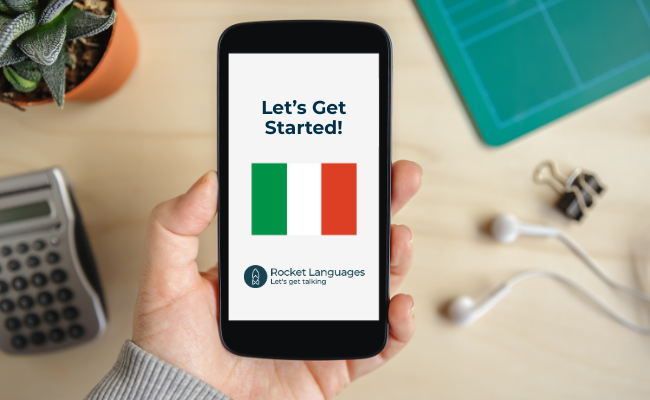Prefer to Listen Instead?
How to Learn Italian Fast
If you've decided to give Italian a try and you're eager to start (or continue) learning the language of Dante, pizza, and colosseo, here are a few hacks to learn Italian fast and and optimize your efforts.

Hack #1: Master Italian Sounds and Pronunciation.
Now that you've decided to learn Italian, it's time to dig into the language learning process. But where should you even begin?
The answer is simple: sounds.
Learning how to hear, pronounce and spell Italian sounds is a great place to get started even before you begin memorizing words and their meanings.
Unlike English, the consistency between written and spoken Italian is rather high, which means that learning how to write and read in Italian guarantees that you’ll be able to master the spoken language. It’s still a good idea to get familiar with Italian sounds before moving forward to the second stage and studying writing.
Standard Italian contains 7 oral vowels, but it only has 5 different letters for all these sounds. Crazy right? But don’t freak out, it’s just a matter of studying a little bit, listening to a ton of Italian, and repeating the sounds until your tongue hurts.
Spend some time just focusing on Italian sounds and spelling so that they are longer foreign to you. Study the Italian alphabet, work on identifying the letters and pronouncing all of the sounds that differ from English sounds.
Get started by trying to pronounce A, B, C, D and E!
Hack #2: Learn Italian on the Go.
Let's face it: you probably have a busy life, and it's difficult to set time aside to study Italian. Fortunately, however, one of the best ways to take advantage of your free time is to learn Italian on the go.
Try the Shadowing Technique
A great way to do this is by taking advantage of American academic and polyglot Alexander Arguelles' Shadowing Technique. This language learning technique involves listening to Italian with earphones and simultaneously repeating it out loud while walking outdoors. There are three main keys to this exercise:
Steps to Shadow Effectively
- Walk outdoors as quickly as possible. If you feel shy or embarrassed to this in public, find a road or path where you can speak Italian loudly and proudly without many other people around you.
- Maintain a perfectly upright posture. According to Arguelles, maintaining a good posture contributes to this method's efficacy.
- Articulate well and in a loud, clear voice. This is very important in order to effectively learn the rhythm, structure and sound of the language.
Say the sounds as soon as you hear them. Don't wait for the entire word. In fact, at first you may only catch a small portion of what's being said and sound like you're speaking nonsense.
This may feel silly at first, but its results will amaze you. By speaking aloud as soon as you hear Italian sounds, you're developing a sense of how the language is structured and sounds, even if you don't understand everything that's being said.
Don't worry if you can't catch and repeat everything. As you improve, you'll gradually begin developing the accent and rhythm of Italian.
Try it yourself using the sample Audio lessons in the FREE trial of Rocket Italian.
Some other great tricks for learning Italian on the go include taking advantage of your morning subway or bus commute by studying flashcards or listening to Italian audio or radio stations in the car.
Make learning Italian a part of your life, and you'll be amazed how much time you have to study when you learn on the go. If you want more on what makes an ideal Italian learning course then check this article out.
Ready to Start Learning Italian the Smart Way?
Hack #3: Learn the Practical Italian Words First.
Lo Zingarelli, one of the biggest and most renowned dictionaries of the Italian language contains about 145,000 words and over 380,000 definitions. Do you need to know them all? Of course not. Don’t waste your time learning words and phrases that you'll never use.
Many experts believe that 300 words may be enough to carry on everyday conversation in Italian, which means that very little memorizing will do the work.
That's right, only 300 words!!
So what does that mean for you as a Italian learner?
By learning the 300 most common Italian words first, you can cut your work in less than half. You'll be able to communicate faster and with significantly less effort. However, it’s highly recommended that you expand your vocabulary at least to the 1,000 most commonly used words in Italian. With just 1,000 words, you'll be able to understand about 80% of written texts.
Common Italian words to get you started
Important! Our Voice Recognition Tool, Rocket Record
Important! Remember What You Learn

Hack #4: Take Advantage of Italian–English Cognates.
Believe it or not, you already know some Italian words even before you even start studying it. While Italian may seem like "Greek" to you, the majority of foreign languages actually share some words or roots of words. These words that look or sound like words in your language and have the same meaning are called cognates.
Almost all European languages share countless cognates with English thanks to their shared roots, history, and evolution. Take the English words "identification," "attention," and "direction," for example. These words exist in Italian with a very similar spelling and just a slightly different pronunciation: identificazione, attenzione, and direzione.
These cognates are your friends and can make your language learning much easier and faster.
Here's a handy list of Italian words by letter that you already know thanks to cognates:
Hack #5. Hooked on Mnemonics.
As many who have learned a foreign language already know, simply repeating vocabulary usually just isn't enough. Sometimes, our brains need a little extra jump start to remember tricky words.
That's where mnemonics come in. Basically, mnemonics involve telling yourself a fun, goofy or memorable story, song, or rhyme to associate with a particular word.
For example, one trick for memorizing the difference between "pèsca" and "pésca" could be: If you are taking a huge bite out of a peach, that’s “pèsca” with a wide “e” sound. If you’re gritting your teeth to yank a huge fish out of the water, that’s “pésca”, fishing, with a narrow “e” sound.
Another fun Italian mnemonic device can help you to remember all of the Italian impersonal verbs (verbs that do not indicate actions, occurrences or states of any specific grammatical subject) is Vagabond blasts car verb rap! Each letter corresponds to an impersonal verb. I will leave it up to you to research and list all of these verbs!
Remember, if you have troubles memorizing a word, phrase, or grammatical rule, you can always make your own mnemonic device!
Hack #6. Keep an Italian Vocabulary Notebook and Flashcards.
As an English teacher, one tip I like to give all of my ESL students is to keep a journal, document, or book with all of the vocabulary they learn in one place.
Not only does keeping a vocabulary journal help you to keep all of your new words and phrases in one place, but the very process of writing down a word and its translation, notes, image or mnemonic device helps you to memorize it.
I've noticed that my students who keep vocabulary journals tend to recall vocabulary much faster and progress much more quickly in their learning.
This notebook can be transformed into study-friendly flashcards by using flashcard generating programs like Anki for your phone or computer. I like to use my Anki flashcards on my phone to learn on the go when I'm on the bus, walking to work or simply waiting in line at the grocery store.

Hack #7: Find the Patterns in Italian Verbs.
You need at least two elements to build a sentence: a noun and a verb. That’s why in Italian, as well as in any other language, verbs are a fundamental part of learning the language. Italian verbs present some obvious difficulties because they can be conjugated into seven moods, four simple tenses, and six persons. But finding the pattern can make your life a lot easier.
With Italian, there are three categories of verbs and a lot of irregular verbs. You should start with the regular verbs divided in three categories depending on the verb infinitive ending. Let's look at three for an example:
- Amare - To love
- Attendere - To wait
- Partire - To depart/leave
First group: Verbs ending in –are
To conjugate a regular -are verb, drop the -are of the infinitive and add the six present tense endings specific to -er verbs: -o, -i, -a, -iamo, -ate, -ano.
Verb conjugations of amare - to love
- Io amo - I love
- Tu ami - You love (casual)
- Lui ama - He loves
- Lei ama - She loves (also formal You)
- Noi amiamo - We love
- Voi amate - You love
- Loro amano - They love
Second group: Verbs ending in –ere
To form the present tense of a regular -ere verb, drop the -ere of the infinitive and add the present tense endings specific to -ere verbs: -o, -i, -e, -iamo, -ete, -ono.
Verb conjugations of attendere - to wait
- Io attendo - I wait
- Tu attendi - You wait (casual)
- Lui attende - He waits
- Lei attende - She waits
- Noi attendiamo - We wait
- Voi attendete - You wait (formal)
- Loro attendono - They wait
Third group: Verbs ending in –ire
To form the present tense of an -ire verb, drop the -ire of the infinitive and add the present tense endings specific to -ire verbs: -o, -i,- e, -iamo, -ite, -ono.
Verb conjugations of partire - to leave
- Io parto - I leave
- Tu parti - You leave (casual)
- Lui parte - He leaves
- Lei parte - She leaves
- Noi partiamo - We leave
- Voi partite - You leave (formal)
- Loro partono - They leave
Irregular verbs
Irregular verbs are a little bit more difficult since they don’t follow a specific pattern. But in order to learn Italian quickly, it’s highly recommended that you learn a few basic irregular verbs such as essere (to be), avere (to have), andare (to go), fare (to do), or potere (can).
Hack #8: Improve Writing with the Scriptorium Technique.
Linguist and polyglot Alexander Arguelles developed another excellent technique for improving your writing and speaking skills simultaneously. It's designed to help you to really focus on the individual components of Italian.
How to Use the Scriptorium Technique
The Arguelles' Scriptorium Technique involves three basic exercises:
- Reading a sentence out loud.
- Saying each word aloud again as you write it.
- Reading the sentence aloud as you have written in.
The purpose of this exercise is to force yourself to slow down and pay attention to detail and look up anything you don't know. It's important to be thorough and meticulous. Find good source material and then copy it carefully, saying each word out loud as you go. Make sure to take the time to check any vocabulary or grammar that you're not sure about as you come across it.
The Scriptorium Technique is a fantastic way to refine and polish your Italian language knowledge, especially at intermediate and advanced levels. The key to mastering this technique is to take your time, be as detailed and thorough as possible, and remember... practice makes perfect.
Hack #9: Read, Watch, and Listen to Italian.
Movies, music, television series, the radio, books, newspapers, magazines and anything you can read, watch, or listen to are unbelievably useful for learning. You've probably already heard cases of people teaching themselves a language by watching movies or playing video games, and while these things don't directly teach grammar, they do help learning it significantly.
Reading, watching and listening to Italian has a remarkable effect on your brain. Simply by being exposed to the language, your brain is put to work. It starts trying to understand new words by making connections to previously learned words and seeks to make sense of any new structures. Basically, you're learning without knowing that you're learning. After a while, you'll find yourself using words and constructions that you didn't even study thanks to your brain's ability to soak up vocabulary and grammar while reading a book, listening to the radio, or watching a series.
Fortunately, Italian is a very culturally rich language. Some of the most celebrated books in the world, such as The Betrothed, The Divine Comedy, or Pinocchio were originally written in Italian. While Italian cinema might not be as globally famous as American cinema, there are some great movies for Italian learners such as Life is Beautiful, The Great Beauty, or Cinema Paradiso.
Books and movies may be difficult to enjoy at the beginning, but as soon as you learn a few words, you’ll be able to understand a lot more than you imagine. Movies with subtitles and bilingual books can be really helpful for those who want to want to jump into audiovisual arts and literature starting from a very early stage of language learning.
If you're extra motivated to learn and practice, use the Shadowing Technique and learn on the go while listening to and repeating your favorite Italian radio station, podcast, TV series or movie. This is a great way to pick up the rhythm, structure, sound and rules of the Italian language without needing to hit the books.

Hack #10. Interact in Italian… Without Travelling to Italy!
Try to interact in Italian on a daily basis. Speaking Italian as much as possible is one of the best tricks to learning it fast (If you want to know how long it takes to learn Italian then check this article out).
Ways to Practice Speaking and Writing
- Speak Italian with a friend, family member or neighbor in person
- Write a letter or email to a friend, family member, coworker, or yourself
- Visit a local store or neighborhood where Italian is spoken and interact with the locals
- Join a weekly or monthly Italian conversation group... or start your own group
- Speak Italian online with a friend, family member, coworker, or fellow language learner (Skype is great for this)
- Contribute to a blog or forum in Italian
- Sing along with Italian music
- Watch an Italian movie, series, documentary or video and repeat the character's lines
- Read a passage from an Italian book, newspaper, or magazine out loud
- Talk to yourself in Italian (this really works!)
The key is to interact, speak, and think in Italian as much as possible. This can be done anywhere and everywhere. Make Italian a part of your daily life!
By following these ten easy Italian learning hacks, you'll learn Italian faster, better, and enjoy doing so.
In bocca al lupo, and happy fast learning!
Maria DiLorenzi: Rocket Italian
